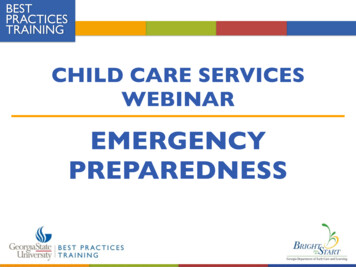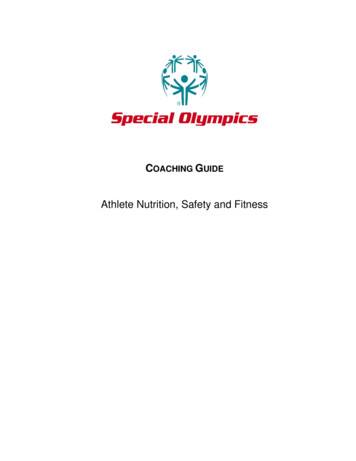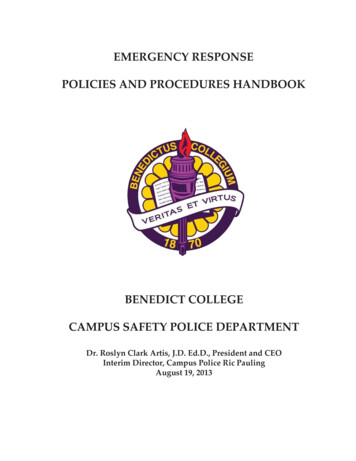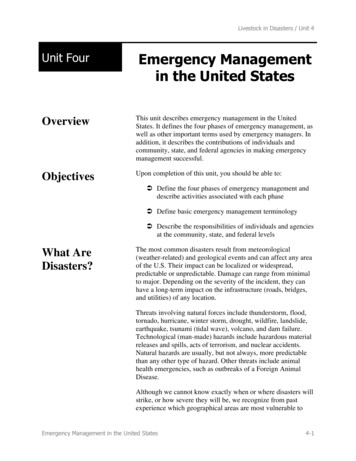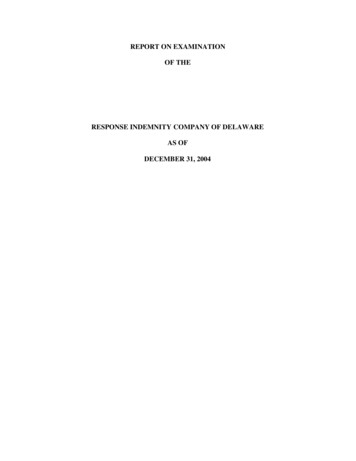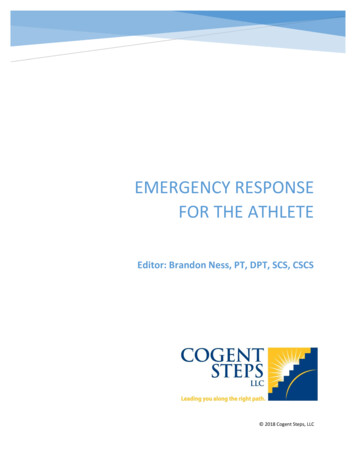
Transcription
2018 Cogent Steps, LLCEMERGENCY RESPONSEFOR THE ATHLETEEditor: Brandon Ness, PT, DPT, SCS, CSCS 2018 Cogent Steps, LLC
2018 Cogent Steps, LLCEditor:Brandon Ness, PT, DPT, SCS, CSCSAssistant ProfessorUniversity of South Dakota – Department of Physical Therapy414 E. Clark StreetVermillion, SD 57069Author Information:Mark D. Anderson, PT, MPT, OCSMountain Land Physical Therapy - Millcreek1153 East 3900 SouthSalt Lake City, UT 84124Angelique Bannister, PT, DPT, SCS, CSCSDirector – U. S. Navy Sports Residency3259 Catlin AveQuantico, VA 22134Brad Eggebraaten PT, SCS, ATCDirector of ATI-Greenville Residency/Fellowship ProgramsATI Physical Therapy200 Patewood Drive Suite C-150Greenville, South Carolina 29615Ann Marie Husk PT, SCS, LAT, ATC, CSCSDuke Sports Medicine Physical TherapyDUMC 3965Durham, NC 27710Becca Jordre PT, DPT, GCS, CEEAA, Cert MDTAssociate ProfessorUniversity of South Dakota – Department of Physical Therapy414 E. Clark StreetVermillion, SD 57069Michele "Shelly" Leavitt Weinstein, PT, MS, SCS, ATCPhysical TherapistAlexandria, Virginia
2018 Cogent Steps, LLCDonna Merkel, PT, MS, SCS, CSCS495 Thomas Jones Way, Suite 100Exton, PA 19341Todd Sander, PT, PhD, SCSAssociate Professor & Director of Clinical EducationArmy-Baylor University Doctoral Program in Physical Therapy3630 Stanley Road, Bldg 2841, Suite 1301Joint Base San Antonio - Fort Sam Houston, TX 78234-6100Abigail Smith, PT, DPT, SCSForward Motion Physical Therapy772 Post Rd East, 2nd Floor, Suite 2Westport, CT 06880Joshua T. Williams, PT, DPT, OCS, SCSAssistant ProfessorDepartment of Rehabilitation SciencesCollege of Allied HealthUniversity of Oklahoma Health Sciences Center1200 Stonewall AveOklahoma City, OK 73117
2018 Cogent Steps, LLCDISCLAIMERIn all course materials, including this publication, care has been taken to ensure theaccuracy of the information and to describe generally accepted practices. However, theauthors, contributors, editors, and publisher are not responsible for errors or omissions or forany consequences from application of the information and make no warranty, expressed orimplied, with respect to the currency, completeness, or accuracy of the contents of thepublication. Application of this information in a particular situation remains the professionalresponsibility of the practitioner; the treatments and management strategies described andrecommended may not be considered absolute and universal recommendations.The authors, contributors, editors, and publisher have exerted every effort to ensurethat the information presented in this text and supplementary material is in accordance withthe current recommendations and practice at the time of publication. However, in view ofongoing research, changes in government regulations, and the constant changes in knowledgeand best practices in this field, the reader is encouraged to rely on their own experience andknowledge in using any information, methods, compounds, or experiments described herein.In applying such information or methods, practitioners should be mindful of personal andpatient safety.For any drugs and medical devices presented in this publication, readers are advised toconsult the most up to date product information (product inserts) provided by themanufacturer of each product to verify dosage or formula recommendations, administrationduration or method, and precautions/contraindications. It is the responsibility of practitioners,relying on their own experience and knowledge of their patients, to make clinical decisions(including diagnosis, dosages, and treatment) for each individual patient, and to take allappropriate safety precautions. It is the responsibility of the practitioner to ascertain the Foodand Drug Administration (FDA) status of each drug or device planned for use in their clinicalpractice.To the fullest extent of the law, neither the publisher nor the authors, contributors, oreditors assume any liability for any injury and/or damage to persons or property as a matter ofproduct liability, negligence or otherwise, or from any use of operation of any methods,products, instructions, or ideas contained in this material (publication and supplementarymaterial) herein.
2018 Cogent Steps, LLCContents: Emergency Response for the AthleteMedical Emergencies in Athletics . 1Considerations for the Young Athlete: Children & Adolescents. 29Sideline Care of the Senior Athlete. 43Gender Differences in Sports Medicine . 58Injuries & Emergent Conditions: Athletes in Adaptive Sports . 84Performance Enhancement Issues in Athletes . 92Sport Variations & Rules for Sideline Care . 99Environmental Considerations . 100Legal & Ethical Concerns for the Athletic Venue. 125
2018 Cogent Steps, LLCMedical Emergencies in AthleticsMichele "Shelly" Leavitt Weinstein, PT, MS, SCS, ATCLearning Goals:Upon completion of this section, the learner will:1. Identify and describe the types of first responders and their training requirements in theUS.2. Differentiate among fractures those with a high potential for loss of limb or life and therequired immediate treatment in the sporting venue.3. Describe the 3 most serious types of cardiac injury leading to death.4. Apply knowledge of the various categories of injury to adapt a sideline medical kit forcoverage of various sports.5. Recall in order, the steps of the Primary and Secondary assessment during emergencycare of the injured athlete.6. Given a wound, determine the best dressing to utilize.7. List the signs and symptoms of shock and the most appropriate treatment8. Explain the rules of splinting.9. Complete a sample Emergency Action Plan for your facility.Objectives:1. Given an injured athlete scenario, apply the tools and skills learned in the primary andsecondary assessment to treat the athlete on the field of play.2. Choose the correct splint to use on an athlete with a suspected ankle fracture.IntroductionThe term Emergency Responder or First Responder has many meanings, definitions andconnotations. The National Institutes for Occupational Safety and Health (NIOSH) reports thereare over 3.5 million emergency response workers in the United States, such as firefighters, lawenforcement officers, emergency medical personnel, cleanup, repair, restoration and recoveryworkers supporting accidents, natural disasters or terrorists’ attacks including nearly 2 millioncareer public safety workers employed full-time in corrections, emergency medical services,firefighting, and law enforcement.1 First responders are those often certified to provideprehospital care in certain jurisdictions such as wilderness responders or community first aidresponders. These personnel attend to medical emergencies until a higher level of care orcertified personnel arrive. The US Homeland Security Presidential Directive HSPD-8 identifiesfirst responders as:Medical Emergencies in Athletics1
2018 Cogent Steps, LLCThose individuals, who in the early stages of an incident, are responsible for the protection andpreservation of life, property, evidence and the environment including emergency responseproviders as defined in Section 2 of the Homeland Security Act of 2002 (6 U.S.C. 101), as well asemergency management, public health, clinical care, public works and other skilled supportpersonnel that provide immediate support services during prevention, response and recoveryoperations.2 Additional definitions include Federal, state and local governmental and nongovernmental emergency public safety, fire, law enforcement, emergency response, emergencymedical (including Hospital emergency facilities) and related personnel, agencies andauthorities.1Licensing and prehospital emergency medical care and oversight of emergency medical services(EMS) are governed at the state level. The Federal government does have a model scope ofpractice including minimum skills for Emergency Medical Responders (EMR), EmergencyMedical Technicians (EMT), Advanced EMT (AEMT) and paramedics established by the NationalHighway Transportation Safety Administration (NHTSA). While states set their ownrequirements, a quasi-national certification body exists. The National Registry of EmergencyMedical Technicians (NREMT) offers a certification based on the NHSTA curriculum.3,4 Specificto prehospital emergency care within the realm of athletics and sports venues, certified athletictrainers (ATC) and board-certified sports physical therapists (SCS) engage in the evaluation andmanagement of injured athletes. According to the National Athletic Trainers’ Association(NATA), certified athletic trainers are health care professionals who collaborate with physiciansand provide services compromised of prevention, clinical diagnoses, therapeutic intervention,rehabilitation and emergency care of injuries and medical conditions.5,6 Board-certified sportsphysical therapists, as recognized by the American Board of Physical Therapy Specialties, arephysical therapists with advanced knowledge and skills in the specialty area of sports.7 It iscommon for sports physical therapists to possess dual credentials as ATC or EMTs.Athletic trainers initially managed emergencies in sports medicine as early as the late 1800s.Formal curriculum and oversight begin in the 1950s with the formation of the NATA.6 In 1954,the ACSM was formed, the predecessor to the American Physical Therapy Association (APTA).With change and growth, in 1974 the APTA recognized its first specialty section was formed,and the sports section gained approval in 1981.7 Since that time, the academic curriculum forsports providers in both athletic training and physical therapy education has advancedsignificantly, where both ATCs and PTs work in various sporting venues including professional,Olympic, college, high school, club sports and non-traditional venues such as the performingarts on Broadway and Cirque de Soleil.Administrative ResponsibilitiesIn 2013, the Boston marathon forever changed the way Emergency Medicine in the sportingenvironment would be planned and managed. Types of sports and competition influence thenature and frequency of injuries, medical coverage provided, as well as the personnel andequipment needed. Motor and equestrian sports carry a significant risk of trauma. Rugby andfootball are high-risk sports. American football and equestrian sports have a significant risk forspinal injuries. Non-contact sports such as golf, tennis and running have a broad range ofMedical Emergencies in Athletics2
2018 Cogent Steps, LLCoveruse injuries, however, they can also result in more orthopedic and trauma related injuries.All sports carry the risk of cardiac events as well as emergencies of anaphylaxis, asthma andhypoglycemia. Spectators and staff are also not immune to emergency medical conditions.8,9The EMR must consider the ages, skills, and any relevant medical history of the athlete. Priorscreening may be beneficial or impractical. Travel with athletes requires consideration ofvaccination, food, and diseases prior to or during the stay. The EMR may only be responsible forthe athletes and staff. Who coordinates care of spectators and crowds? Does the opponenthave a capable medical staff trained in emergencies that can be called on to assist? The EMRmust be familiar with the venue, available key personnel, ambulance request and access andfacilities. The Hillsborough disaster of 1989 and subsequent Gibson report recommended aseparate medical staff for crowds greater than 2000 and an onsite ambulance for crowds over5000 or more.8Contractual AgreementsThe EMR may be employed or contracted for a team, school, or event organizer. Several keyquestions should be asked in lieu of such agreements. What medical staff is necessary for theevent? Are there protocols and a physician on site to provide oversite and standing orders?Other categories that need to be considered are transportation, communication, medicalequipment, medications, documentation, security and insurance. How are volunteers vettedand trained prior to an event?Whether providing care at a high school football game or a nationally renowned marathon,sports providers must collaborate with the local EMS including but not limited to arranging forpermits, protocols, and transportation.8 In 1966, the NHTSA established minimal standards forout of hospital care for accident victims. In 1969, the first Emergency Medical Techniciantraining program was established. There are currently four levels of certification / licensure withvariation in skills, practice, knowledge qualification, services provided, risk, level of supervision,autonomy, critical thinking and judgment. All are part of a continuum of care. Table 1 lists thelevels and training requirements according to provider.3,4 The EMS system still relies on thepublic for being first on the scene and identifying the emergency and initiating the call to beginthe chain of survival with EMS.3,4,10 In the sports environment, it is the ATC, PT or physician thatmay initiate the chain of survival. All events should have a written Emergency Action Plan (EAP)as recommended by the NATA.5,11-17Table 1. National EMS Scope of Practice Model*3,4Emergency MedicalResponder (EMR)Primary focus is toinitiate immediatelifesaving care tocritical patientsFunction as part of aMedical Emergencies in AthleticsPossesses basicknowledge and skillsnecessary to providelifesaving interventionswhile awaitingadditional EMSresponse and to assistEducationalRequirements: One ofthe eligibilityrequirements at thislevel is successfulcompletion of anaccredited Emergency3
2018 Cogent Steps, LLCcomprehensive EMSresponse, undermedical oversighthigher level personnelat the scene and duringtransport.Medical Respondertraining program.Possesses the basicknowledge and skillsnecessary to providepatient care andtransportation.EducationalRequirements: One ofthe eligibilityrequirements forlicensure at this level issuccessful completionof an accreditedEmergency MedicalTechnician coursePossesses basicknowledge and skillsnecessary to providepatient care andtransportation.Advanced EmergencyMedical Techniciansfunction as part of acomprehensive EMSresponse, undermedical oversightEducationalRequirements: One ofthe eligibilityrequirements forlicensure at this level issuccessful completionof an accreditedAdvanced EmergencyMedicalTechnician coursePossesses the complexknowledge and skillsnecessary to providepatient care andtransportation.EducationalRequirements: Becauseof the amount ofcomplex decisionmaking, one of theeligibility requirementsPerform basicinterventions withminimal equipmentEmergency MedicalTechnician (EMT)Primary focus is toprovide basicemergencymedical care andtransportation forcritical and emergentpatientsFunction as part of acomprehensiveEMS response, undermedical oversightPerform interventionswith the basicequipment typicallyfound on anambulance.Advanced EmergencyMedical Technician(AEMT)ParamedicPrimary focus is toprovide basicand limited advancedemergency medicalcare andtransportation forcritical andemergent patientsAEMTs performinterventions with thebasic and advancedequipment typicallyfound on anambulance.Is an allied healthprofessional whoseprimary focus is toprovideadvanced emergencymedical care for criticalMedical Emergencies in Athletics4
2018 Cogent Steps, LLCand emergent patientswho access the EMSParamedics performinterventions with thebasic and advancedequipment typicallyfound on an ambulanceParamedics function aspart of acomprehensive EMSresponse, undermedical oversightfor licensure requiressuccessful completionof a nationallyaccredited Paramedicprogram at thecertificate or associatesdegree levelThe Paramedic is a linkfrom the scene into thehealth care system*For the purpose of this model, one licensure level is substantially different from otherlicensure levels in: Skills Practice environment Knowledge Qualifications Services provided Risk Level of supervisory responsibility Amount of autonomy Judgment/critical thinking/decision makingThe skills utilized by the sports EMR are paramount to early assessment of life threatingsituations including ensuring airway, breathing, and circulation, in addition to assessing forsevere bleeding, shock, and providing venue care and determining the need for definitive care.The EMR must be prepared for all types of trauma including those that may occur to spectators,coaches, or others tangentially involved in the venue. The process of primary and secondaryassessment is tried and true. The concept of the sports provider as part of the EMS system iskey in assessing and treating athletes in emergencies. Sports PTs and ATCs serve a similarcapacity as an EMR with focus on the athlete, while using of evidence-based practice within thescope of their license or practice act. These professionals often have the benefit of knowing theathlete well, as well as understanding stress and the emotional impact of an injury.5,19,20EpidemiologyAthletic injury severity occurs along a continuum. Many sports injuries are minor (sprains,strains, abrasions), which require immediate care and treatment with subsequent return toplay. Other injuries are more serious and require further assessment and treatment, and maynecessitate follow up to ensure the athlete is safe to return to play. Other injuries are lifethreatening involving the “ABC’s” which include airway, breathing, and circulation. Other lifethreatening injuries include severe bleeding, cardiac emergencies, shock or other catastrophicinjury that must be promptly recognized and acted upon immediately to preserve life. TheNational Center for Catastrophic Sports Injury Research (NCCSIR) tracks catastrophic injuriesand illnesses pertaining to organized sports participation for the collegiate, high school, andMedical Emergencies in Athletics5
2018 Cogent Steps, LLCyouth levels, with the intent to enhance the prevention, recognition, management andrehabilitation of catastrophic injuries in athletics. Catastrophic injuries include those that resultin permanent disability, serious head injuries, cervical spine fractures, temporary paralysis,sudden cardiac arrest or sudden cardiac disruption, exercise-related heat stroke, or fatalities.21Sports medicine providers need to be aware of these injuries and work towards decisions thatimprove safety and decrease risk. Rule changes, written EAP protocols, and access to advancedmedical care can all improve outcomes and the safety of sports participants.5,8,11-17,19,21Although football garners the most attention for both catastrophic injury and fatalities, othersports such as swimming and diving, as well as pole vaulting are among other sports withsignificant injury rates. In the last ten years, there have been fatal injuries in other sportsincluding baseball.21 Table 2 lists several examples of fatal injuries according to sport. Eachsport influences the nature and frequency of injury as do other factors, including practice vscompetition, skill level, age of the athlete, preexisting pathology, protective equipment, playingsurfaces, environmental factors, and on-site medical staff to oversee participation and prescreening efforts.8,11-13,17,19,20,22-28Table 2. Report of Catastrophic Injuries/Illness in High School & College; 2012 – 2015*2012/132013/142014/15Baseball1/1Cross country1/0Football10/527/218/3Gymnastics1/0Ice k & Field1/0Wrestling1/0*Sports not reported had no catastrophic injuries/illnesses for years reportedSports medicine providers share responsibility for the health, well-being, and care of athletes.This includes the athletes, the organization, spectators and crowds, the teams, and the medicalstaff present. When caring for any of these populations, healthcare personnel need to be awareand familiar with the venue, key locations, and access to definitive care. Several questionsregarding coverage responsibilities should be proactively addressed. Are we responsible for theother participants? Spectators? The Hillsborough disaster of 1989 brought many of thesefactors to the forefront of venue management.8Other ResponsibilitiesThe sports medicine venue provider needs to be aware of weather conditions and the effects ofweather on athletic participation. Are the proper protocols and standards in places to care forMedical Emergencies in Athletics6
2018 Cogent Steps, LLCathletes? Who ultimately makes the decision for “go – no go “decision?26 NATA has clearlyarticulated position statement on Emergency Planning in Athletics as well as Exertional HeatIllness, Lightning Safety, Prevention of Sudden Death in Sports, and Acute Management of theCervical Spine Injured Athlete.11-17,27-29 The EAP addressed areas of communication,transportation, equipment, medications, documentation, and security. All the planning,prevention, and administrative tasks are paramount to safe participating and action during anemergency. All participants benefit from trained emergency responders who are present andable to recognize, evaluate, treat, and refer injured athletes as soon as possible to lessen amore serious injury and to refer the athlete to advanced care as necessary.Primary AssessmentThe initial or primary assessment or survey is designed to detect all immediate threats to life.These include airway, breathing, and circulation (ABC’s), as well as severe bleeding and shock.The primary assessment has six components: 8,111. General Impression. Looking at the scene, determining the mechanism of injury,seriousness and condition of the injured athlete. Other impressions include level ofdistress, mental status, and observation of visible injuries.2. Mental Status. Using the Alert, Verbal, Painful, Unresponsive (AVPU) scale, the firstpriority is determining level of responsiveness. Alert athletes are responsive, awake,oriented and talking. In the Verbal level, the athlete responds to loud stimulus and theresponse may include grunts, speaking, groans or eye-to-eye contact. Painful responsesuch as a sternal rub or pinch will elicit a response from the athlete. Unresponsive is thefinal level of status.3. Airway. In an unresponsive athlete, the airway must be opened and assessed forbreathing using either a head-tilt-chin-lift or jaw-thrust technique. The airway should beassessed for five to ten seconds using visual and palpable clues.4. Breathing. Once the airway is open, an assessment of breathing must be done. Observefor the chest to rise and feel for air exchange. Listen to the quality of the breath sounds.5. Circulation. Assessing the pulse at the carotid or radial artery if there is breathing. Checkskin signs including color temperature and moisture.6. Bleeding and Shock. Observing and treating for profuse, bright red spurting bleedingthat is indicative of an arterial bleed. Any uncontrolled bleeding may become lifethreatening and lead to shock.At this point in the primary assessment, if the person is unresponsive, has a blocked airway,is not breathing, has no pulse, or has severe arterial bleeding, immediate action must betaken. Calling for advanced medical care, arranging transportation, beginningcardiopulmonary resuscitation (CPR), rescue breathing, or treatment for bleeding andshock. It is imperative for the EMR to have supplies and equipment to provide care andprotect themselves while rendering care. Personal protective equipment includes gloves,mask, eyewear and a resuscitation mask. Additionally, if oxygen is available, its use shouldbe encouraged. Care to stop bleeding includes using sterile dressings, trauma dressing, or aMedical Emergencies in Athletics7
2018 Cogent Steps, LLCtourniquet if appropriate. The goal is to stabilize and sustain life until advanced care arrivesand transports the athlete to definitive care.5,10,18Airway & BreathingSeveral medical emergencies, illnesses, or injuries can lead to compromise of an athlete’sairway. Airway injuries may be caused by trauma to the face, skull, and neck. Soft tissue injuriesand bleeding to the oral or nasal cavity causes swelling and may lead to immediate or delayedairway compromise. Injuries to the larynx or trachea will also produce soft tissue swelling andpossible damage to cartilage or fractures of the larynx, distorting the airway. Paralysis mayoccur due to damage of the laryngeal nerve or the carotid artery. These primarily occur insports with contact or collision “clothesline” injuries or from sharp blades such as hockeyskates. Athletes with these types of injuries need to have a full assessment of the airway andcervical spine with consideration given to dyspnea, hoarseness, laryngeal tenderness, stridor orpainful or difficulty swallowing or talking.5,10,18 The EMR should also look for other signs ofrespiratory distress including fear, agitation and cyanosis.5,8,10,18Acute Asthma. Outdoor venues are a greater trigger for attacks and include pollen and grasseswhile dust or chemicals may trigger indoor attacks. The classic presentation includes wheezing,breathlessness, and coughing. Dry and cold air contributes to exercise-induced asthma, whichirritates the airway mucosa whereas classic symptoms usually occur toward the end or aftervigorous exercise. Treatment should be initiated with the appropriate medications such as ashort acting β-2 agonist.5,8 Standing protocols may call for use of an inhaler or nebulizer if theathlete does not have their own inhaler.18,29 Other emergencies that create shortness of breath(SOB) and require differential diagnoses include anaphylaxis, pneumonia, pneumothorax, andpulmonary edema. The key is the exam and severity of peak expiratory flow (PEF). In moderateSOB, symptoms will increase PEF at 50-75% of peak, and severe PEF of 33-50% respiration willincrease heart rate and respiration. Athletes will be unable to complete a sentence in onebreathe. Life threatening airway emergencies include signs and symptoms of PEF 33%, nobreath sounds, cyanotic, bradycardic, hypotensive and decreased or lack of responsiveness withan 02 saturation of less than 92%.5,18 The position of comfort for these athletes is a sitting ortripod position. Complete the primary assessment and vital signs, and use emergency oxygen at15 L/minute with a non-rebreather mask, and if appropriate, a nebulizer and or prednisone forfive days.5Anaphylaxis is a systemic response from an allergen after the first exposure with asensitization. The response is a Type 1 immunoglobin-mediated response to common allergenssuch as nuts, strawberries, and insect venom. It is imperative for the EMR to be aware of theirathletes’ medical history and carry appropriate treatment such as an EpiPen . Injection ofepinephrine is considered a “life first” action and should be used if anaphylaxis hasoccurred.5,8,18 Anaphylaxis manifests with the signs and symptoms that include swelling of theairway, tongue, and mucosa, and tingling of the lips. The epinephrine needs to be injectedthrough the thigh, and circulated into the blood stream before it can act systemically. Usually 5to 10 minutes is required for the medication to have positive effects. Therefore, inject into ahighly vascular large muscle like the thigh or butt, then CALL 911 - because the EpiPen can be atemporizing measure, but there is still danger after getting the injection because it does notMedical Emergencies in Athletics8
2018 Cogent Steps, LLCwork that fast.30 People with true anaphylaxis are anxious, often have a skin rash, or swelling.When someone with anaphylaxis arrives to the emergency room, epinephrine is administeredimmediately, and the patient is prepared for a breathing tube or cricothyroidotomy becausethe likelihood is low that epinephrine will reduce throat swelling in time. Anaphylaxis is a Type 1hypersensitivity reaction caused by a large cascade of inflammatory proteins cause bloodvessels to become "leaky", spilling fluid into the tissues of the throat, causing swelling andthroat closing. The epinephrine helps to partially reverse this process, but it takes time forswelling to resolve; the fluid in those swollen tissues will suddenly just disappear. Flushed skin,difficulty and increased breathing rates, rashes and urticaria are all responses. 18,30Seizures. Seizures can compromise the airway. Initially keep the athletes safe from injury bymoving objects out of the way. As soon as the seizure ends, assess both cardiac and respiratorysystems in the primary assessment. The athlete may have decreased LOC, may request to beput in a position of comfort, and/or require oxygen/medication. Nothing should be placed inthe mouth of a seizing athlete and the responder should look for any emergency identificationtags.5,8,18Pulmonary Embolism. PE’s are not common in athletes, but can result from post-surgicalcomplications or travel. Presentation may include chest pain, SOB, calf pain, and decreased O2saturation. These athletes can present with cardiac arrest. Immediate care in needed along withemergency oxygen. A history may include previous deep vein thrombosis or recent calf pain.5,8Pneumonia. While not an acute emergency, pneumonia should be considered in athletes whoare sick and
firefighting, and law enforcement.1 First responders are those often certified to provide prehospital care in certain jurisdictions such as wilderness responders or community first aid responders. These personnel





